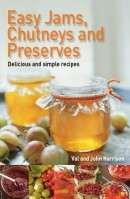Marmalade making is very similar to jam making but the rind needs much longer cooking so more water is required. The fruit is simmered until the rind is soft and the volume of liquid has reduced by about half.

Val Harrison Making Marmalade
Jelly marmalades are made in the same way but are strained through a jelly bag after the fruit has been cooked and strips of rind are then added.
Although the bitter Seville oranges with their short season of December to February in the shops are most popular, any citrus fruit can be used for making marmalade.
Bitter or sweet oranges, lemons, grapefruit, tangerines, satsumas etc. on their own or in various combinations. You can use the marmalade process with other fruits such as quince where it serves to soften tough rinds.
Flavourings such as ginger, Armagnac, whisky, rum, brandy, treacle and apricots can be added but the citrus flavour must predominate.
The same equipment is required for making marmalade that is used for jams and jellies with the addition of a good sharp knife and a juice extractor. You will also find some weighing scales that are large enough to take your preserving pan and adjustable to compensate for the weight of the pan really useful.
Pectin
The pectin in citrus fruit is contained in the white pith and pips. Extra acid is often added to ensure a good set as only about 450 g (1 lb) of fruit is used to make 1.4 kg (3 lb) of marmalade.
Preparation of Fruit
- Wash and lightly scrub the fruit and dry thoroughly.
- Slice or shred the fruit according to preference and recipe and, for thick marmalade, tie the pips in a muslin bag. If you dislike pith in your marmalade, remove it from the peel, chop roughly and add this in with the pips to the muslin bag.
- For jelly marmalade it’s always preferable to remove as much pith as possible from the peel. It can go back in with the fruit as it will be strained off later in the process.
- Put the fruit, juice and other ingredients into a pan with the muslin bag and add water as per recipe.
Making Thick Marmalade – Method
- Put all the ingredients into a pan with the pips in a muslin bag, bring to the boil and simmer gently until the peel is soft. This will take between 1½ – 2 hours. You can also use less water and boil in a pressure cooker on medium for about half the time but we find it more controllable to cook with an open pan on the hob.
- Lift out the bag of pips, squeezing it again the side of the pan with a wooden spoon.
- Test for pectin. If a large clot forms, the pectin is adequate to obtain a good set. If the clot is poor or thready, add the juice of two lemons to each 900 g (2 lb) fruit used and continue simmering the fruit until a good pectin clot is obtained.
- Remove from the heat, stir in the sugar until it has dissolved.
- Return to the hob, bring to the boil and boil and boil rapidly for 15 – 35 minutes until the marmalade sets when tested.
- Test for setting just like jam – put a little marmalade on to a cold plate, cool, and if the marmalade wrinkles when touched with the finger it is cooked sufficiently and will set. Always draw the pan away from the heat when testing for “set”, otherwise the marmalade may over cook.
- Skim off any excess sugar scum using a perforated spoon and then add a knob of butter and stir in to reduce any remaining scum. Do this a soon as possible after setting point has been reached as, if left much longer, the scum tends to cling to the pieces of peel.
- Leave the marmalade to cool slightly so that the peel will not rise to the top of the jar.
- Pour the marmalade into clean, dry, hot sterilized jars.
- Put a circle of waxed paper, waxed side down on the top of the marmalade.
- Wipe the jars clean.
- Cover with lids or cellophane covers whilst the marmalade is still hot.
- Leave to cool and when quite cold label up, giving the type of marmalade and date when it was made.
- Store in a cool, dark, dry place.
Making Jelly Marmalades – Method
Wash the fruit carefully and remove the peel very thinly, removing as much pith as possible. Cut the peel into fine strips and tie in a piece of muslin. Cut the remaining fruit and pith into pieces and place in a bowl, together with the muslin bag.
- Pour on the water and leave to soak overnight
- Transfer to a preserving pan, bring to the boil and simmer gently until the peel is soft and the contents of the pan have been reduced. This will take 1½ – 2 hours. Remove the bag of shredded peel after it has cooked for about an hour (it depends on the fruit) so that it does not over cook. Rinse it in cold water and set aside.
- Turn the contents of preserving pan into a jelly bag and leave to strain overnight.
- Test for pectin.
- Measure the juice and heat it in a pan. Add 450g (1 lb) warmed sugar to each 570 ml (1 pint) of juice, stir until all the sugar has dissolved. Add the shredded peel.
- Bring to the boil and boil rapidly until the marmalade sets when tested.
- Remove the scum and let the marmalade cool a little so that the peel does not rise to the top of the jelly.
- Pour into clean, dry, hot sterilized jars.
- Wipe the jars clean and cover with lids or cellophane covers whilst still hot.
- Leave to cover and, when cold, label giving the type of marmalade and date on which it was made.
- Store in a cool, dry place.
More in Jams, Jellies & Marmalades
- Jam and Jelly Making Method
- Jam and Jelly Making – Fruit, Acid, Sugar and Water
- Equipment Required for Jam and Jelly Making
- Pectin – How to Test for Pectin
- Pectin for Jam, Jelly & Marmalade Making
- Making Jams in Microwave & Bread Machines etc.


